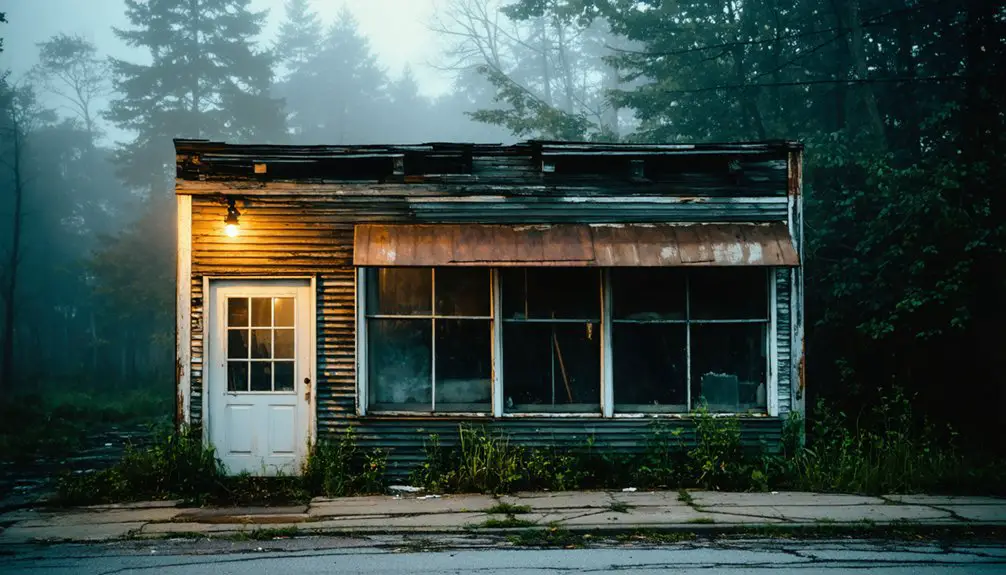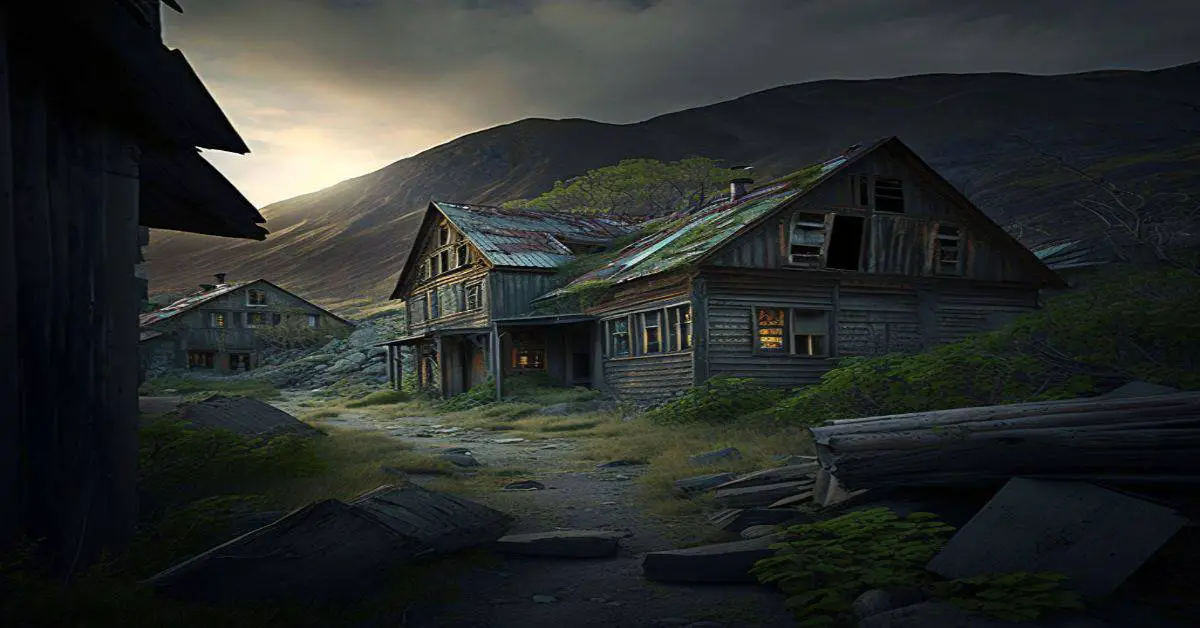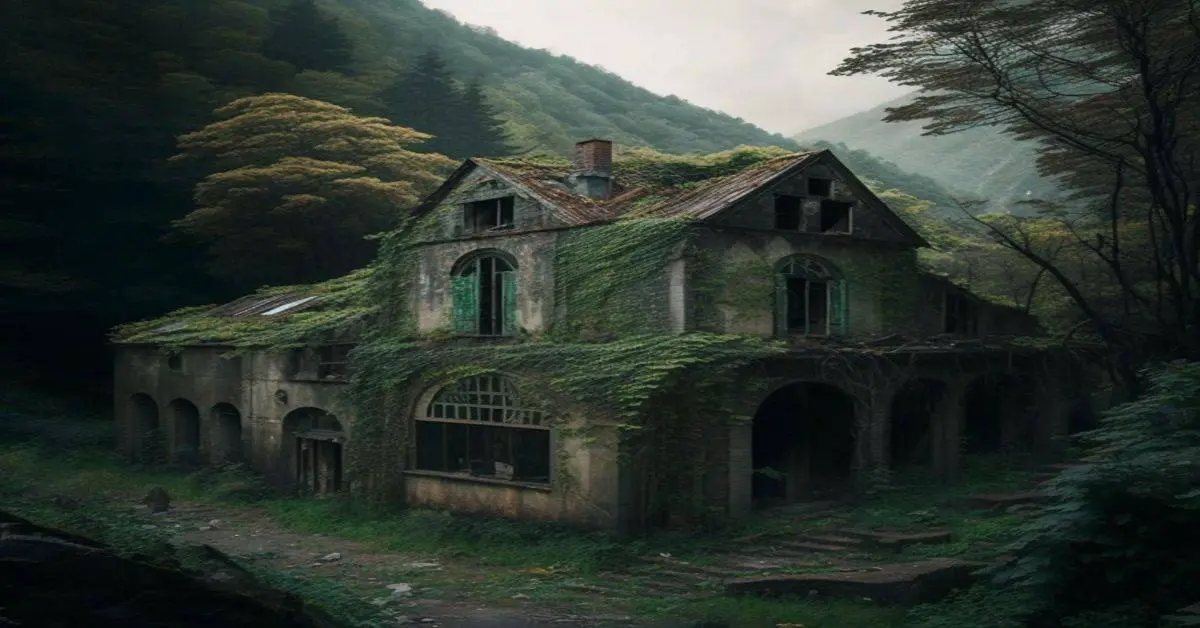You’ll find Superior’s ghost town ruins in Michigan’s Upper Peninsula, where a once-bustling copper mining community thrived during the mid-1800s. The town peaked when it supplied 95% of America’s copper by 1869, with over 140 mines operating in the Keweenaw Rift region. Today, you can explore deteriorating industrial structures, rusted machinery, and self-guided interpretive trails through the reclaimed landscape. The site’s rich history of Cornish immigrants and mining innovations awaits your discovery.
Key Takeaways
- Superior, Michigan became a ghost town after the collapse of its copper mining industry, which had supplied 95% of America’s copper by 1869.
- The town’s abandonment occurred in the mid-20th century, leaving behind skeletal buildings, empty lots, and rusted industrial machinery.
- Visitors can explore the ruins through self-guided interpretive trails, though access requires navigating remote roads and hiking to historical sites.
- The site preserves cultural heritage from Cornish immigrants and Native Americans, with annual gatherings maintaining mining town traditions.
- Historical structures, including a 1906 schoolhouse and mining equipment, remain as testament to the once-thriving frontier mining community.
The Rise of a Mining Powerhouse
When Michigan state geologist Douglass Houghton reported rich copper deposits in 1841, he sparked an industrial mining revolution that would transform the Upper Peninsula into America’s copper capital.
By 1845, you’d find companies like Jackson Iron rushing to stake their claims across a 100-mile mineral belt stretching through Ontonagon, Houghton, and Keweenaw counties.
The copper boom brought unprecedented growth, with over 140 mines dotting the Keweenaw Rift region.
You’ll find mining innovations evolved rapidly from basic hand-drilling to sophisticated operations featuring 45-ton steam engines by 1852.
The first successful commercial operation began at the Phoenix and Cliff mines in the mid-1840s.
Native peoples had long extracted copper from surface outcroppings before industrial mining began in earnest.
These advancements helped Michigan dominate America’s copper production, supplying over three-quarters of the nation’s copper between 1850 and 1881, reaching an astounding 95% of national output by 1869.
Life in Superior’s Golden Era
As Michigan’s copper industry flourished, Superior transformed from a remote outpost into a vibrant frontier community.
You’d find Cornish immigrants bringing their mining expertise while establishing homes with their families near the bustling mine sites. Community interactions centered around local hotels, churches, and saloons, where immigrant traditions merged with frontier life.
You could’ve witnessed a town alive with activity, where miners’ children attended basic schoolhouses while their parents labored in the mines or supported the community through essential businesses. Residents gathered each year for annual reunion services to maintain connections with their mining heritage.
Though living conditions were harsh, with basic utilities and ever-present mining hazards, the town fostered a rich social fabric. Local sawmills, general stores, and recreational facilities served both permanent residents and transient workers, creating a self-sustaining economy built on mining but diversified through necessity. The Elm River Township school, built in 1906, provided education for children from kindergarten through eighth grade.
The Decline and Abandonment
Following the Central Mine’s peak production of 52 million pounds of copper, Superior’s decline proved swift and devastating.
The economic impacts hit hard as copper deposits dwindled and mining costs soared, leading to the mine’s closure in 1898. You’d have witnessed massive population migration as miners and their families dispersed to other mining regions or returned to Cornwall. The tragic 1872 mining accident, which claimed ten miners’ lives, had already foreshadowed the challenges ahead. The ten times wealthier copper boom ultimately could not sustain the one-industry town.
The town’s abandonment happened quickly, leaving behind skeletal buildings and empty lots where vibrant neighborhoods once stood.
What remained were decaying mineshafts and industrial ruins along U.S. 41. While the physical structures crumbled, the community’s spirit endured through annual reunions, like the Central Mine Sunday service started in 1907, where former residents gathered to honor their resilient past.
Exploring the Ruins Today
Today’s visitors to Superior’s ruins will find themselves traversing a landscape where nature has steadily reclaimed the once-bustling mining town. For urban exploration enthusiasts, the site offers deteriorating industrial structures, rusted machinery, and weathered foundations along Lake Superior’s shoreline.
Crumbling concrete and twisted metal emerge from overgrown brush, as nature slowly consumes Superior’s abandoned industrial past.
You’ll need to navigate remote roads and possibly hike to access these historical preservation sites. Pack sturdy boots and safety gear, as you’ll encounter unstable structures and sharp metal debris. The Champion Mill operations began in 1901 and marked the beginning of decades of industrial activity in the area. The region’s annual 300 inches of snow makes winter exploration particularly challenging.
While exploring, you can photograph the remnants of mining operations, examine old metal coiling, and discover how the harsh lake weather continues to shape these ruins.
Consider camping nearby for a multi-day visit, but remember to check with the Michigan DNR first. Cell service is limited, so come prepared for self-sufficient adventure.
Cultural Heritage and Local Legends
While copper mining dominated Superior’s economic narrative, the town’s cultural heritage runs far deeper through layers of Native American spirituality, immigrant traditions, and local folklore.
The Cornish miners brought their expertise and played a vital role in shaping Superior’s early development.
You’ll discover a rich tapestry of cultural continuity woven through preserved churches, mystical folklore, and stories passed down through generations of miners’ families.
- Native burial grounds and the legendary Keweenaw Vortex connect you to ancient spiritual beliefs
- The spiral-shaped healing tree stands as a symbol of indigenous mystical traditions
- Churches like Central Mine’s 1868 building showcase immigrant communities’ resilience
- Local guides share tales of sudden evacuations and abandoned belongings
- Annual gatherings keep mining town traditions alive at preserved historical sites
The community’s deep connection to the land is evident in Winona’s schoolhouse, which continues operating with just six students despite the town’s dramatic population decline.
Today, you can explore this blend of mining heritage and spiritual significance through guided tours that bring these compelling stories to life.
Planning Your Ghost Town Visit
Making the most of your visit to Superior’s ghost towns demands thoughtful preparation, particularly given the remote Upper Peninsula location and variable conditions you’ll encounter.
Access routes via US-41 and M-28 lead to most sites, though you’ll need to navigate some less-maintained roads to reach specific locations.
Plan your exploration between late spring and early fall when weather conditions are most favorable. You’ll want to pack water, snacks, and appropriate outdoor gear since amenities are scarce at most sites.
Consider basing yourself in nearby towns like Calumet or Houghton, where you’ll find lodging and supplies. Before heading out, check local weather forecasts and contact area historical societies for updated access information and tour possibilities.
Many locations offer self-guided interpretive trails, letting you explore at your own pace.
Frequently Asked Questions
Are There Any Reported Ghost Sightings or Paranormal Activities in Superior?
You won’t find documented evidence of ghostly encounters in Superior itself, though nearby ghost towns report spectral apparitions. Local legends focus more on the area’s natural energies and mining-related paranormal activity.
What Happened to the Mining Equipment and Machinery After the Town’s Abandonment?
You’ll find most mining relics were either salvaged by other companies or deteriorated over time, though some equipment preservation efforts saved select pieces for historical documentation and local museums.
Did Any Original Superior Families Maintain Properties Through Generations Until Today?
Like scattered seeds in winter, your family history search won’t find continuous property lineage in Superior. While some descendants maintain nearby seasonal homes, no original families kept their properties uninterrupted through generations.
What Natural Disasters or Accidents Contributed to Superior’s Eventual Decline?
You won’t find major floods or notable mining accidents in Superior’s decline story. Instead, its demise came from grinding economic pressures, resource depletion, and the slow exodus of workers seeking opportunities elsewhere.
How Deep Were the Copper Mines Beneath Superior’s Town Site?
You’ll find these copper mines reached staggering depths, with shafts extending over 6,000 feet vertically beneath the surface, while some inclined shafts stretched even deeper to 9,000 feet during peak mining history.
References
- https://gandernewsroom.com/2023/06/28/7-michigan-ghost-towns-you-might-not-find-on-your-map-2/
- https://www.visitkeweenaw.com/things-to-do/museums-history/ghost-towns/
- https://www.uptravel.com/things-to-do/attractions/fayette-historic-state-park-townsite/
- https://beltmag.com/ghost-towns-lost-and-found/
- https://www.smithsonianmag.com/history/once-a-year-this-19th-century-michigan-ghost-town-comes-to-life-180982695/
- https://www.greatlakesnow.org/2020/06/copper-mining-history-lake-superior-minnesota/
- https://en.wikipedia.org/wiki/Copper_mining_in_Michigan
- https://nmu.edu/upperpeninsulastudies/mining-history
- https://ironoreheritage.com/history/
- https://www.nps.gov/kewe/learn/historyculture/copper-mining-timeline-page-2.htm


